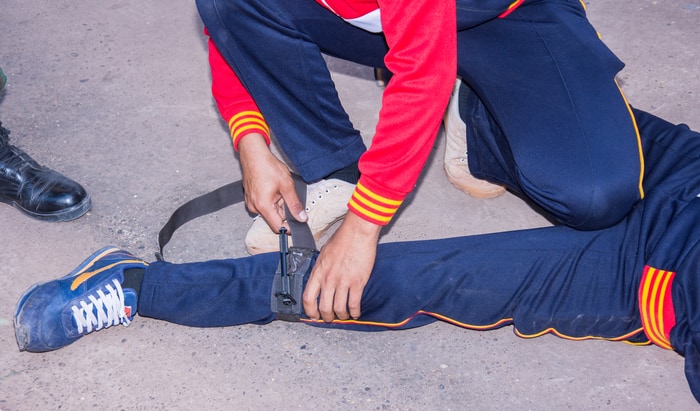News that knife crime convictions in England and Wales are at a record high – courts dealt with 19,000 cases in 2016 with increases driven by juvenile offenders – has reignited the debate about whether the population should be routinely ‘upskilled’ when it comes to first aid. In particular, there is discussion about the whether people should be trained how to how to use a tourniquet to staunch blood loss in the event that they come across a stabbing victim – or they are stabbed themselves.
I have to admit that I am torn. Yes, applying a tourniquet properly in the correct situation can save someone’s life.
Yes, applying a tourniquet properly in the correct situation can save someone’s life.
But there is also evidence to show that wrongly using a makeshift tourniquet can make blood loss worse, and it should only be used in a small number of cases where bleeding is catastrophic, and if direct pressure is not working.
First aid at work courses already include an option on how to correctly use a tourniquet, but even this is controversial. The fact is that workers in abattoirs or farmers in remote locations operating heavy machinery may possibly need to use a tourniquet, but your average office workeris unlikely to ever run into a situation where this is required. The recommendations remain that heavy bleeding should be treated first with direct pressure and packing the wound or using a tourniquet are second line treatments when direct pressure is insufficient or impossible.
At First Aid for Life, the company I launched in 2007 to teach first aid to people from all walks of life, we regularly visit schools and youth centres where stabbings sadly happen all too frequently. This is really the arena where people may need to learn how to deal with blood loss and devastating deliberate injuries. But even here, our first priority is prevention. The skills required for damage limitation come second to getting the message across that stab wounds can kill quickly and people who carry knives are more likely to be the victims of stabbing themselves.
We use quite graphic images and shock value to help young people think about the casualness of knife crime. There really are people who think you can jab someone in the leg or torso and it will have few consequences.
There really are people who think you can jab someone in the leg or torso and it will have few consequences.
The reality is that you can sever an artery in the leg and cause bleeding which kills your victim in a few short minutes. Tiny stab wounds that barely bleed can often kill, as people underestimate the internal damage and hidden bleeding that can quickly lead the casualty to go into shock.
Only after we have hammered home the devastating realities of knife crime, do we move onto what you can do to help a victim. And very few young people faced with this situation are going to have a reliable tourniquet to hand. It is not just stopping the blood loss by applying a tight ligature. You have to be able to keep the ligature tight so it doesn’t loosen. Better that they treat the wound conventionally and call an ambulance so that specialist medics can take over.
And if a tourniquet, improvised or otherwise, is applied, there is no going back. Those who use them in a crisis situation must be prepared for the pain and anguish felt by the victim who may even be screaming at them to stop. Releasing a tourniquet is not an option after a very few minutes because levels of toxins start to build up in the limb which has been deprived of oxygenated blood. If someone looses the stricture, those toxins can flood back into the blood stream and cause toxic shock and death.
All things considered, I think that first aid trainers should reserve training for tourniquet use to those in special circumstances who face substantial risk.
- What is a seizure? - 13th March 2025
- Febrile Convulsions and Seizures in Children - 13th March 2025
- Why women are less likely to receive CPR or survive cardiac arrest - 6th March 2025


